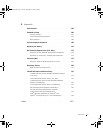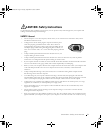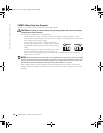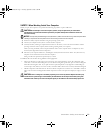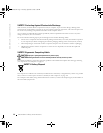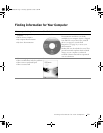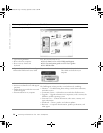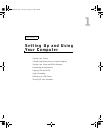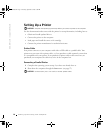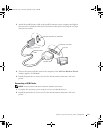
12 CAUTION: Safety Instructions
www.dell.com | support.dell.com
SAFETY: Protecting Against Electrostatic Discharge
Static electricity can harm delicate components inside your computer. To prevent static damage, discharge static
electricity from your body before you touch any of your computer’s electronic components, such as the microprocessor.
You can do so by touching an unpainted metal surface on the computer chassis.
As you continue to work inside the computer, periodically touch an unpainted metal surface to remove any static
charge your body may have accumulated.
You can also take the following steps to prevent damage from electrostatic discharge (ESD):
• Do not remove components from their antistatic packing material until you are ready to install the component
in your computer. Just before unwrapping the antistatic packaging, discharge static electricity from your body.
• When transporting an electrostatic sensitive component, first place it in an antistatic container or packaging.
• Handle all electrostatic sensitive components in a static-safe area. If possible, use antistatic floor pads and
workbench pads.
SAFETY: Ergonomic Computing Habits
CAUTION: Improper or prolonged keyboard use may result in injury.
CAUTION: Viewing the monitor screen for extended periods of time may result in eye strain.
For comfort and efficiency, observe the ergonomic guidelines in the Tell Me How help file when setting up and using
your computer.To access help files, see page 32.
SAFETY: Battery Disposal
Your computer uses a lithium coin-cell battery. The lithium coin-cell battery is a long-life battery, and it is very possible
that you will never need to replace it. However, should you need to replace it, see page 110.
Do not dispose of the battery along with household waste. Contact your local waste disposal agency for the address of
the nearest battery deposit site.
J2936bk0.book Page 12 Tuesday, September 2, 2003 3:06 PM






